One of the things that sickens me is the amount of clothing I pick off of the beach. This Textile -Throwaway Problem is not just a San Diego beach problem.. it is a global issue that costs each and every one of us. Just in my little 1 mile of beach:
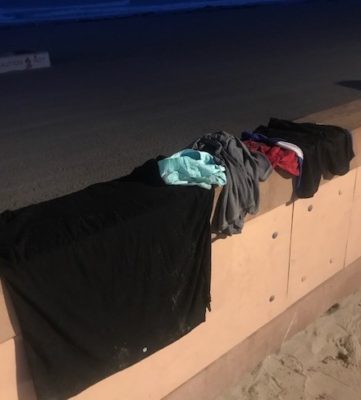
Over 2018 I picked up:
- 1000+ socks: Unfortunately most socks are so sandy and destroyed) The only place to donate them is the Goodwill. But you still have to wash them.
- 500+ underwear: Nobody will take underwear. They are all put in the trash. The guilt!
- 1000+ Shoes Donated, given away or sold.
- 655 Clothing Items donated
- 700+ Clothing items sold or given away or on hand
- 100 Hats donated
- 100 cheap sunglasses (technically fast fashion, but not textiles)
- 100 cheap items of jewelry (technically fast fashion, but not textiles)
This does not even count the same amount of clothing that is in the trash cans in the parking lots, clothing I left behind, clothing I had to UGH.. throw away, clothing that the homeless picked up, clothing that the other pickers picked up and clothing that the Park and Recreation staff picked up and threw away and clothing that is washed away.
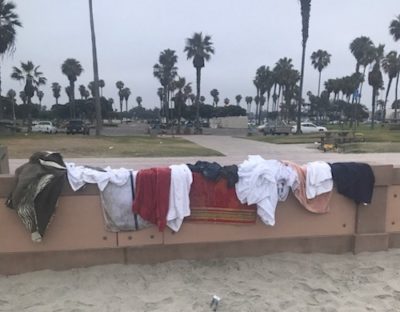
That is over 4000 items of clothing just thrown away and left on the beach.. IN ONLY 1 MILE OF BEACH... in 1 year. 11 items of Fast Fashion- Textiles per day average. I didn’t even pick up beach trash everyday. 180 tracked days to be exact. That equates to 22.2 pieces of textiles per day. If I went out everyday that equates to 8,222 items of clothing per year or. If I salvaged every piece of clothing from the beach, parking lots and picnic areas and the trashcans… the numbers would most likely be to over 12,000 items of clothing. per year in 1 Mile of Beach.
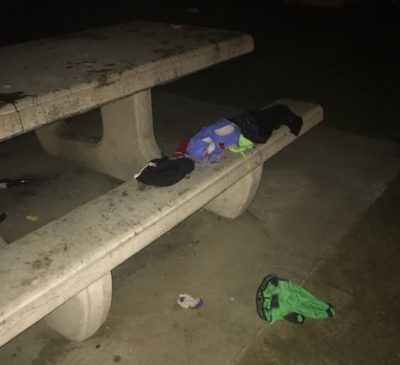
What about all the other textiles that are not technically in the fashion space?
Other Textiles
- 217 Towels donated
- 400+ Towels sold
- 200 Towels on hand
- 100 Towels given away or used.
- 50 Blankets Donated
- 25 Blankets sold or given away
- 20 Sheets sold or donated.
- Not counted: fabric from beach chairs, fabric from umbrellas, textiles from sleeping bags, backpacks, sheaths for chairs and umbrellas, canopy canvasses, sandbags, purses, wallets….
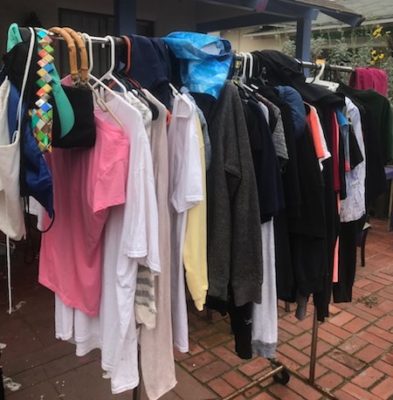
San Diego has 70 Miles of Coastline… with 62 beaches. Can you imagine if every mile contained this much clothing? On a conservative estimate.. I picked up 1 ton of clothing-textiles-fast-fashion in 2018. If you picked the top 20 beaches in San Diego.. would that equate to 20 tons of textiles in one year. Add in California’s 840 miles of Coastline.. it is too horrifying to think about. 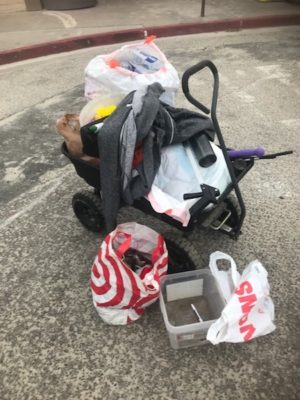
This is all due to Fast Fashion and a Throwaway Society. For the record, most of these clothes are from millennials.
Fashion is “incredibly wasteful and harmful to the environment.” designer Stella McCartney
What is Fast Fashion? Fast Fashion is when you buy throwaway clothes. Cheap clothes, trendy clothes, wear it once and bam.. you don’t like it or it goes out of style and it is just thrown away. Fast Fashion retailers such as H&M, TopShop, Zara, Forever21, Target, Mango, Gap, Old Navy, Espirit, Urban Outfitters produce the look and designs from the runways.. make them fast and cheap… and guess what.. I find them all on the beach.
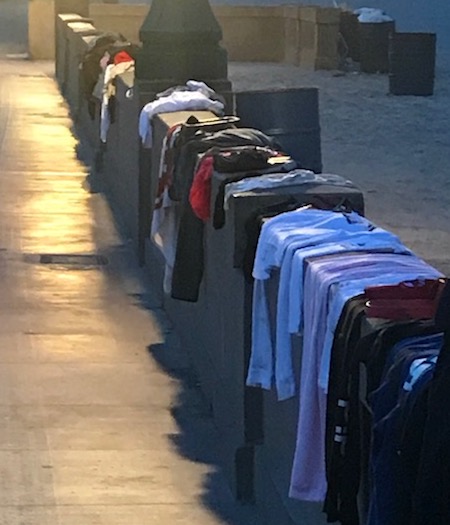
How Big Is The Market?
- $1.3 trillion in the USA and employs around 300 million people.
- 100 Billion Garments a Year.
- 450 Million pieces of Denim is the USA Consumer demand (JCR-VIS)
- 2% a year increase in clothing demand.
- $45.00/ ton USD cost cities to dispose of clothes
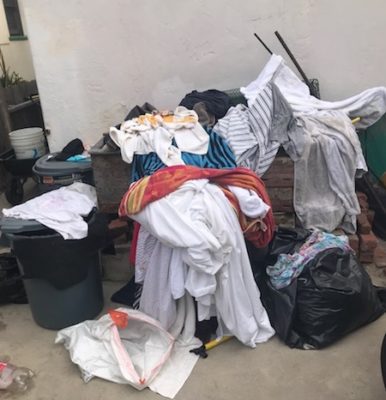
Then you have brands who deliberately destroy their clothes… all which go into landfills…
- Burberry: criticized in 2018 when it was announced that they destroyed $36 Million n clothes and perfume in 2017. After this news went viral.. Burberry said in September that it would ban this practice.
- January 2017 , The New York Times: Nike store in Soho threw out several bags of unworn shoes, all of which had been slashed with box cutters so no one could wear them.
- H&M — a so -called leader with a ‘green agenda’ — burned about 19 tons of obsolete clothing. At least they were reused in a in a waste-to-energy facility in Sweden. Mälarenergi.
- JCPenney (Pittsburgh) told local media that the company was requiring them to destroy specific Ralph Lauren merchandise. “We’ve destroyed blankets. We’ve destroyed shirts, sweatshirts.’
- Fashion journalist Erika Kawalek claimed she knew of a “VERY high-up and profitable” fashion label that “sent two million dollars worth of clothing and purses to the shredder” rather than donating the goods, lest its wares end up on the unwashed masses “or in some unsightly discount bin.
Survey Says State of Reuse Report
- 33% said he or she doesn’t because it’s more convenient to throw things away.
- 54% said they’ve thrown away an item because they didn’t think it would be accepted by a donation center.
- 74% of people said they’d be more likely to donate old clothing if they knew that a center would take items regardless of condition.
What is the price?
Coming into a market buy low and sell cheap only encourages cheap labour as more and more companies seek to reduce costs… which leads to…
Human Slavery and Child Labor:
- 260 million children are in employment globally. (International Labour Organization (pdf)). Of that 260 million- 170 million are engaged in child labour, as “work for which the child is either too young – work done below the required minimum age – or work which, because of its detrimental nature or conditions, is altogether considered unacceptable for children and is prohibited”. (United Nations) Much of this child labor is in the fashion industry.
- 6 Million Children are in Forced Labor
- For the record.. H&M, Forever21, GAP, Aldo, Primark, Adidas, Walmart, Victoria’s Secret, Aeropostale are a few of the garment companies that have been accused of using child labor. (Source)
Unsafe Working Conditions
- 2013 Savar building collapse or Rana Plaza collapse was a structural failure that occurred on 24 April 2013 in the Savar Upazila of Dhaka District, Bangladesh, where an eight-story commercial building named Rana Plaza collapsed. The search for the dead ended on 13 May 2013 with a death toll of 1,134.[2] Approximately 2,500 injured people were rescued from the building alive.[4] It is considered the deadliest structural failure accident in modern human history, and therefore also the deadliest garment-factory accident in history (Wikipedia)
Waste of Natural Resources: Water Waste
- 20% – The average amount of global industrial water pollution that can be tied to garment manufacturing. (World Resources Institute).
- 85 %- of water used in textile processing goes into dying the fabrics. This can leads to run off, polluting waters. (Cotton, Inc.).
- 715 gallons – To produce the cotton needed for one t-shirt – That equates to almost 3 years of drinking water. (WWF).
- 1,800 gallons – Water to grow enough cotton to produce just one pair jeans. (Tree Hugger).
- 25 billion gallons –The water required for one year’s worth of global textile production (includes cotton). (Elle MacArthur Foundation).
- 1.3 trillion gallons – The amount of water used each year for fabric dyeing alone. (World Resources Institute).
- 1,900 – Individual fibers that can be rinsed off a single synthetic garment (mainly polyester) that will end up in our oceans. (The Guardian).
- two billion t-shirts are sold worldwide and 520 million pairs of jeans are sold in the U.S. With the production of one t-shirt using up 700 gallons of water and one pair of jeans using up 1,500 gallons,
A Levi’s plant in El Paso, TX uses 15% of the city’s water supply. In a study by Levi’s, researchers found that manufacturing one pair of jeans requires 400 mega joules of energy, and expels 71 pounds of carbon dioxide. The amount of carbon dioxide emitted to produce one pair of jeans is equivalent to driving 78 miles.
Deforestation
- Geres a French environment agency estimated that Textile-garment factories in Phnom Penh (Cambodia) burn through 2.3 million cubic feet of wood monthly… Where do they get that wood.. forests.. Cambodia has the 3rd highest rate of deforestation in the world…. what does that lead to.. illegal logging.
- 70 million trees are cut all over the world to feed the fashion industry. Fabrics such as rayon, viscose, modal are all contributing to deforestation.
- 30% of rayon and viscose used by the apparel industry comes from these endangered forests according to some research.
Landfill Space
- 10 x the average garment is worn.
- 70 pounds of clothing and other textiles thrown away yearly by Americans yearly.
- 26 Billion Pounds of textiles end up in landfills
- 5% of all landfill space is taken up by textiles. Environmental Protection Agency (EPA).
- 3.8 Billion pounds of post consumer textile waste is recycled.. which is only 15% of all textiles. (EPA Estimates)
- This does not even count packaging.

Pollution
- The textile industry (which includes towels, clothing, furniture and more) is the 2nd largest polluter of clean water? The first is agriculture.
- 4000 people killed everyday in China due to air pollution from denim companies.
- 6.5 million people die yearly because of air pollution and clothing companies are some of the worst.
- 20% of industrial water pollution is due to garment manufacturing, while the world uses 5 trillion liters (1.3 trillion gallons) of water each year for fabric dyeing alone, enough to fill 2 million Olympic-sized swimming pools. (World Resource Institute)
- Cotton farming takes enormous amounts of waters and pesticides. Causes stress on water resources, biodiversity and soil quality.
- Clothing shed Micofibers that add more plastic to our oceans and drinking water. Equats to approximately 50 million plastic bottles yearly.
- 300 Kgs of chemicals that are used for every 900Kg of animal hides tanned. (Good on You)
- Use of cheap materials increases the use of toxins.
- clothes pollute the ocean with microfibers
Fashion- Climate change
- 3% of all global CO2 emissions is from the Fashion Industry or 163 million new cars on the road.
- By 2050 the fashion industry will use up a quarter of the world’s carbon budget.
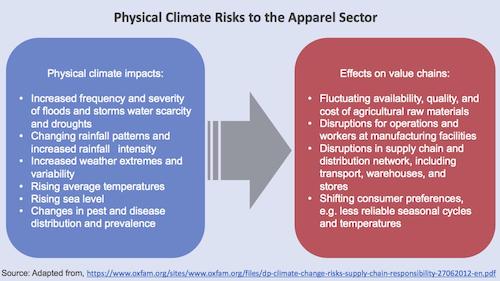
Encourages a Throwaway mentality.
- The throw-away society is a human society strongly influenced by consumerism. The term describes a critical view of overconsumption and excessive production of short-lived or disposable items over durable goods that can be repaired. (Wikipedia)
- Social Media: Research by Barclaycard states one in 10 UK shoppers bought clothes online with the intent to wear them for social media and then return their temporary wardrobe. (Decan Chronicle)
What Are The Solutions?
Fortunately Ethical Fashion is growing. Fashion companies are looking at their supply chain and taking steps to reduce their impact on the earth and maximize the benefits to the people. Leaders such as Stella McCartney have started organizations to encourage a circular fashion economy.
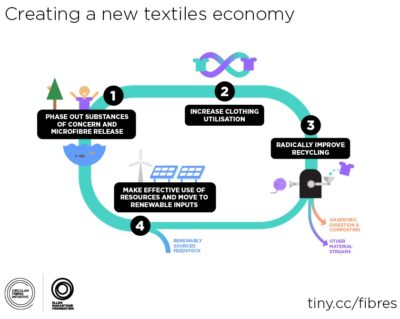
- 100,000 – Pairs of jeans that Levi recently manufactured with one of its Chinese suppliers using 100 percent recycled water. (Levis).
- 1 million – Adidas Ocean Plastic Sneakers that they sold in 2017. Each pair of shoes reuses 11 plastic bottles. (CNBC)
- 25 – The number of recycled plastic bottles (reclaimed from the ocean) that activewear brand Girlfriend Collective uses to make each pair of its leggings. (TFL).
And in the UK it is estimated annually, the clothing and textiles sector in the UK alone produces:
- 3.1 million tons of CO2
- Two million tons of waste
- 70 million tons of wastewater
- 1.5 million tons of unwanted clothing being landfilled
What can we do? British designer Vivienne Westwood, “buy less, choose well, make it last.”
- Look at the companies and labels and buy from sustainable companies
- Support companies that are committed to ethical fashion.
- Buy better quality products.
- Keep product longer.
- Reduce amount of clothing purchased.
- Buy from Second Hand Stores.
- Buy clothing that comes from recycled products .
- Wash less and hang dry.
- Care for your clothes better. Better clothing will last longer.
- Recycle all fabrics. Goodwill will take almost everything.
Just think if 300 million Americans recycle just one t-shirt, we would save up to 210 billion gallons of water and keep up to 1 million pounds of CO2 out of the atmosphere.
Companies
- GUESS is partnered with I:CO®, (I:Collect), a global solutions provider and innovator for the collection, certified sorting, reuse and recycling of used apparel and footwear, to launch a wardrobe recycling program.
- UltraTouch™ Denim Insulation collect used denim to use for insulation in the USA.
- The Blue Jeans Go Green program has collected more than 2 million pieces of denim as of 2018 with the support of its partners.
- Reformation, a US brand has created a lingerie collection made from recycled fabrics.
- reGAIN app helps turn unwanted clothing into discounts.
As I picked up 6 pair of socks, 3 shoes, 2 T’shirts and one blanket the other day, I wonder if we will ever get away from our disposable life?
Resources
- Waste360
- Huff Post: T-Shirt Environment
- The Guardian: Unicef Child Labor
- Blue Cotton: 55 Things You Probaby didn’t know about T-shirts
- https://www.pbs.org/newshour/nation/how-to-stop-13-million-tons-of-clothing-from-getting-trashed-every-year
- https://www.thebalancesmb.com/textile-recycling-facts-and-figures-2878122 ******
- http://www.dailyinfographic.com/how-many-pounds-of-textiles-are-trashed-every-year
- https://www.greenpeace.org/international/story/7539/fast-fashion-is-drowning-the-world-we-need-a-fashion-revolution/
- http://www.takepart.com/video/2015/05/29/clothes-trash-landfill
- https://bkaccelerator.com/america-leads-world-textile-waste-unwanted-clothing/
- Cotton
- Detox The Catwalk
- .The trend has also been criticized on intellectual property grounds, with some designers alleging that their designs have been illegally mass-produced by retailers.
- A New Textile Economy:
- Love Not Landfill is funded by the European Clothing Action Plan and London Waste And Recycling Board,

Cathy, this is such an important post and so well-researched! Now if only we cold get politicians to pay attention..and the public! There is a good book about this topic called: overdressed, the high cost of cheap fashion. And also a movie which reallyshocked me: “the true cost movie”.
Do you have “planetaid” bins in your area? They will take all textiles for recycling. I put everything in there, including torn rags and old torn socks. They do expect items to be clean. That is your biggest problem..how to wash all the stuff you collect so that it can be recycled…one would think you have enough that they would even pick up from your house on a regular basis. I wonder if there is an organization you could partner with who would pick up the washing tab? You are doing such important work..and as you say: just a one-mile stretch of beach. Why are people so completely irresponsible?
Saw the true cost and very depressing. We do have planetaid, but but in a 10 mile radius of my house, we have 10 places to donate, including 2 Goodwill’s, Salvation Army, Am Vets. Celebral Palsy plus more. you are right the biggest problem is the cleaning of all, especially when they are ‘sand-soaked’. Much of these clothes are stained with who knows what and you cannot get them cleaned. Add into the fact about California’s water issues.. you are always torn, wash and waste water or put in the landfills. I just wish that people took care of their stuff